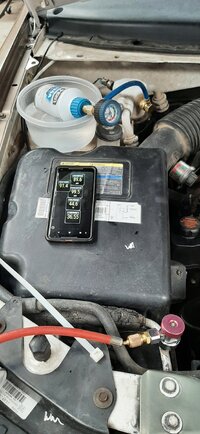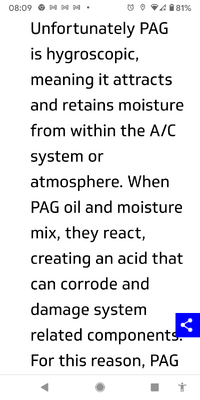On my way back from Utah, the A/C started to blow cool, but not cold. It wasn't bad enough to worry too much about it, but figured I'd look into it. Got a new orifice tube and 2 14 ounce cans of R134 freon. Replaced the orifice tube (there was nothing on it) and pumped it down to 30" of vacuum for about 1/2 hour.
Closed the valves for about 10 minutes, vacuum held, so I was pretty confident there was no leaks.
The A/C charge for this says 1.85 lbs. (29.6 ozs.). Hooked up the first can and shot it in as a liquid ( can upside down, ignition off) on the high side, took the whole can no problem. On the second can, I put it in as a vapor with the car started, and it took FOREVER to get the whole can in, probably 45 minutes. Finally aggrivated me, and I jumped the switch at the accumulator so the compressor ran all the time.
Because the can was warm, I knew the freon wasn't going in to the system. The hi side pressure was 190, low side 40. The freon should have been flowing, as I'm pretty sure the pressure in the can was greater than 40.
Then, just like that, the can got cold and went in.
So I'm wondering, is this some crazy thing I don't know about with the TB A/C? Like it won't turn on unless the blower is on?
Just for the truly anal retentive on this list, while it was pumping down, I took the grill off and cleaned the bugs out of the condenser. There were plenty of them.
I also wondered about the fan clutch, but no, it was good.
Ever happened to anyone else here?
Closed the valves for about 10 minutes, vacuum held, so I was pretty confident there was no leaks.
The A/C charge for this says 1.85 lbs. (29.6 ozs.). Hooked up the first can and shot it in as a liquid ( can upside down, ignition off) on the high side, took the whole can no problem. On the second can, I put it in as a vapor with the car started, and it took FOREVER to get the whole can in, probably 45 minutes. Finally aggrivated me, and I jumped the switch at the accumulator so the compressor ran all the time.
Because the can was warm, I knew the freon wasn't going in to the system. The hi side pressure was 190, low side 40. The freon should have been flowing, as I'm pretty sure the pressure in the can was greater than 40.
Then, just like that, the can got cold and went in.
So I'm wondering, is this some crazy thing I don't know about with the TB A/C? Like it won't turn on unless the blower is on?
Just for the truly anal retentive on this list, while it was pumping down, I took the grill off and cleaned the bugs out of the condenser. There were plenty of them.
I also wondered about the fan clutch, but no, it was good.
Ever happened to anyone else here?


